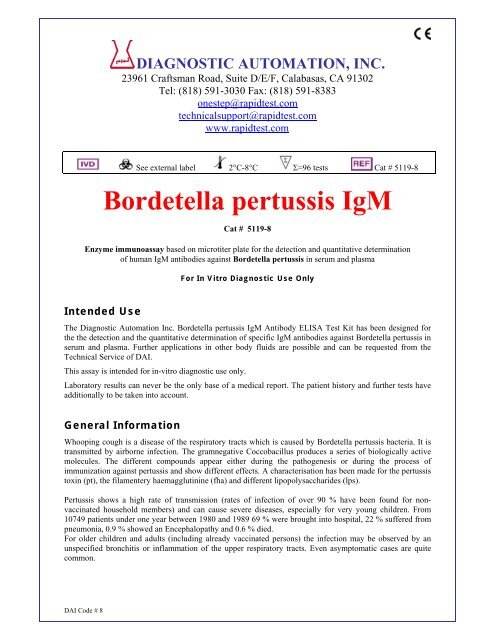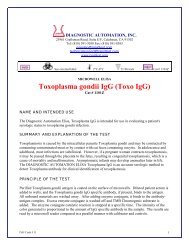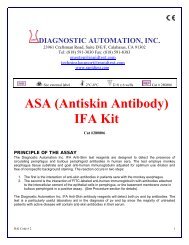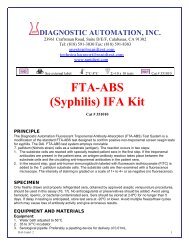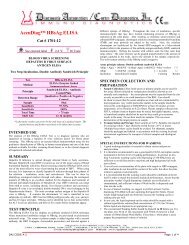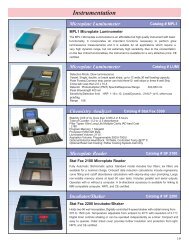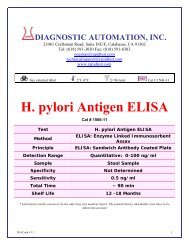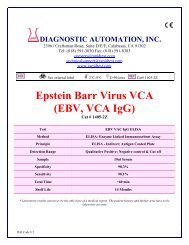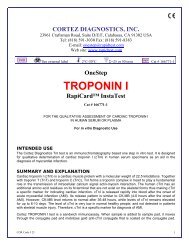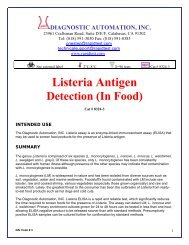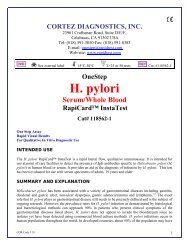Bordetella pertussis IgM - ELISA kits - Rapid tests
Bordetella pertussis IgM - ELISA kits - Rapid tests
Bordetella pertussis IgM - ELISA kits - Rapid tests
You also want an ePaper? Increase the reach of your titles
YUMPU automatically turns print PDFs into web optimized ePapers that Google loves.
DIAGNOSTIC AUTOMATION, INC.<br />
23961 Craftsman Road, Suite D/E/F, Calabasas, CA 91302<br />
Tel: (818) 591-3030 Fax: (818) 591-8383<br />
onestep@rapidtest.com<br />
technicalsupport@rapidtest.com<br />
www.rapidtest.com<br />
See external label 2°C-8°C Σ=96 <strong>tests</strong> Cat # 5119-8<br />
<strong>Bordetella</strong> <strong>pertussis</strong> <strong>IgM</strong><br />
Cat # 5119-8<br />
Enzyme immunoassay based on microtiter plate for the detection and quantitative determination<br />
of human <strong>IgM</strong> antibodies against <strong>Bordetella</strong> <strong>pertussis</strong> in serum and plasma<br />
For In Vitro Diagnostic Use Only<br />
Intended Use<br />
The Diagnostic Automation Inc. <strong>Bordetella</strong> <strong>pertussis</strong> <strong>IgM</strong> Antibody <strong>ELISA</strong> Test Kit has been designed for<br />
the the detection and the quantitative determination of specific <strong>IgM</strong> antibodies against <strong>Bordetella</strong> <strong>pertussis</strong> in<br />
serum and plasma. Further applications in other body fluids are possible and can be requested from the<br />
Technical Service of DAI.<br />
This assay is intended for in-vitro diagnostic use only.<br />
Laboratory results can never be the only base of a medical report. The patient history and further <strong>tests</strong> have<br />
additionally to be taken into account.<br />
General Information<br />
Whooping cough is a disease of the respiratory tracts which is caused by <strong>Bordetella</strong> <strong>pertussis</strong> bacteria. It is<br />
transmitted by airborne infection. The gramnegative Coccobacillus produces a series of biologically active<br />
molecules. The different compounds appear either during the pathogenesis or during the process of<br />
immunization against <strong>pertussis</strong> and show different effects. A characterisation has been made for the <strong>pertussis</strong><br />
toxin (pt), the filamentery haemagglutinine (fha) and different lipopolysaccharides (lps).<br />
Pertussis shows a high rate of transmission (rates of infection of over 90 % have been found for nonvaccinated<br />
household members) and can cause severe diseases, especially for very young children. From<br />
10749 patients under one year between 1980 and 1989 69 % were brought into hospital, 22 % suffered from<br />
pneumonia, 0.9 % showed an Encephalopathy and 0.6 % died.<br />
For older children and adults (including already vaccinated persons) the infection may be observed by an<br />
unspecified bronchitis or inflammation of the upper respiratory tracts. Even asymptomatic cases are quite<br />
common.<br />
DAI Code # 8
The serological response following <strong>pertussis</strong> disease or immunization with <strong>pertussis</strong> vaccine has been<br />
measured with agglutination assays, precipitins, complement fixation and enzyme-linked immunosorbent<br />
assay (<strong>ELISA</strong>).<br />
Enzyme-linked immunosorbent assays, in which <strong>Bordetella</strong> antigen (containing toxin, FHA and LPS and<br />
standardized in U/ml) is bound to a solid phase support, are sensitive, easy to perform and can be used both<br />
to determine seropositivity with a single serum and to indicate recent <strong>Bordetella</strong> infection by determination<br />
of <strong>IgM</strong> and IgA.<br />
Principle of the Test<br />
The DAI <strong>Bordetella</strong> <strong>pertussis</strong> <strong>IgM</strong> antibody test kit is based on the principle of the enzyme immunoassay<br />
(EIA). <strong>Bordetella</strong> antigen is bound on the surface of the microtiter strips. Diluted patient serum or ready-touse<br />
standards are pipetted into the wells of the microtiter plate. A binding between the <strong>IgM</strong> antibodies of the<br />
serum and the immobilized <strong>Bordetella</strong> antigen takes place. After a one hour incubation at room temperature,<br />
the plate is rinsed with diluted wash solution, in order to remove unbound material. Then ready-to-use antihuman-<strong>IgM</strong><br />
peroxidase conjugate is added and incubated for 30 minutes. After a further washing step, the<br />
substrate (TMB) solution is pipetted and incubated for 20 minutes, inducing the development of a blue dye in<br />
the wells. The color development is terminated by the addition of a stop solution, which changes the color<br />
from blue to yellow. The resulting dye is measured spectrophotometrically at the wavelength of 450 nm. The<br />
concentration of the <strong>IgM</strong> antibodies is directly proportional to the intensity of the color.<br />
Limitations, Precautions and General Comments<br />
• Only for in-vitro use! Do not ingest or swallow! The usual laboratory safety precautions as well as the<br />
prohibition of eating, drinking and smoking in the lab have to be followed.<br />
• All sera and plasma or buffers based upon, have been tested respective to HBsAg, HIV and HCV with<br />
recognized methods and were found negative. Nevertheless precautions like the use of latex gloves have<br />
to be taken.<br />
• Serum and reagent spills have to be wiped off with a disinfecting solution (e.g. sodium hypochlorite, 5%)<br />
and have to be disposed of properly.<br />
• All reagents have to be brought to room temperature (18 to 25 °C) before performing the test.<br />
• Before pipetting all reagents should be mixed thoroughly by gentle tilting or swinging. Vigorous shaking<br />
with formation of foam should be avoided.<br />
• It is important to pipet with constant intervals, so that all the wells of the microtiter plate have the same<br />
conditions.<br />
• When removing reagents out of the bottles, care has to be taken that the stoppers are not contaminated.<br />
Further a possible mix-up has to be avoided. The content of the bottles is usually sensitive to oxidation, so<br />
that they should be opened only for a short time.<br />
• In order to avoid a carry-over or a cross-contamination, separate disposable pipet tips have to be used.<br />
• No reagents from different kit lots have to be used, they should not be mixed among one another.<br />
• All reagents have to be used within the expiry period.<br />
• In accordance with a Good Laboratory Practice (GLP) or following ISO9001 all laboratory devices<br />
employed should be regularly checked regarding the accuracy and precision. This refers amongst others<br />
to microliter pipets and washing or reading (<strong>ELISA</strong>-Reader) instrumentation.<br />
• The contact of certain reagents, above all the stopping solution and the substrate with skin, eye and<br />
mucosa has to be avoided, because possible irritations and acid burns could arise, and there exists a<br />
danger of intoxication.<br />
Reagents Provided<br />
Store kit components at 2-8 o C and do not use after the expiry date on the box outer label. Before use, all<br />
components should be allowed to warm up to ambient temperature (18-25 o C). After use, the plate should be<br />
DAI Code # 8<br />
2
esealed, the bottle caps replaced and tightened and the kit stored at 2-8 o C. The opened kit should be used<br />
within three months.<br />
Components<br />
Volume / Qty.<br />
<strong>Bordetella</strong> <strong>pertussis</strong> antigen coated microtiter strips 12<br />
Negative Control<br />
2 mL<br />
Cut-Off Standard<br />
2 mL<br />
Weak Positive Control<br />
2 mL<br />
Positive Control<br />
2 mL<br />
Enzyme Conjugate<br />
15 mL<br />
Substrate<br />
15 mL<br />
Stop Solution<br />
15 mL<br />
Sample Diluent<br />
60 mL<br />
Washing Buffer (10×)<br />
60 mL<br />
Plastic foils 2<br />
Plastic bag 1<br />
1. Microtiter Strips<br />
12 strips with 8 breakable wells each, coated with a <strong>Bordetella</strong> <strong>pertussis</strong> antigen (complete bacterial antigen,<br />
serotype 1,2,3). Ready-to-use.<br />
2. Calibrator A (Negative Control)<br />
2 mL, protein solution diluted with PBS, contains no <strong>IgM</strong> antibodies against <strong>Bordetella</strong>. Addition of 0.01%<br />
methylisothiazolone and 0.01% bromonitrodioxane. Ready-to-use.<br />
3. Calibrator B (Cut-Off Standard)<br />
2 mL human serum diluted with PBS, contains a low concentration of <strong>IgM</strong> antibodies against <strong>Bordetella</strong>.<br />
Addition of 0.01 % methylisothiazolone and 0.01 % bromonitrodioxane. Ready-to-use.<br />
4. Calibrator C (Weak Positive Control)<br />
2 mL, human serum diluted with PBS, contains a medium concentration of <strong>IgM</strong> antibodies against<br />
<strong>Bordetella</strong>. Addition of 0.01 % methylisothiazolone and 0.01 % bromonitrodioxane. Ready-to-use.<br />
5. Calibrator D (Positive Control)<br />
2 mL, human serum diluted with PBS, contains a high concentration of <strong>IgM</strong> antibodies against <strong>Bordetella</strong>.<br />
Addition of 0.01% methylisothiazolone and 0.01% bromonitrodioxane. Ready-to-use.<br />
6. Enzyme Conjugate<br />
15 mL, anti-human-<strong>IgM</strong>-HRP (rabbit), in protein-containing buffer solution. Ready-to-use. Addition of 0.01<br />
% methylisothiazolone and 0.01 % bromonitrodioxane and 5 mg/L Proclin TM . Ready-to-use.<br />
7. Substrate<br />
15 mL, TMB (tetramethylbenzidine). Ready-to-use.<br />
8. Stop Solution<br />
15 mL, 0.5 M sulfuric acid. Ready-to-use.<br />
9. Sample Diluent<br />
60 mL, PBS/BSA buffer. Addition of 0.1 % sodium azide.<br />
10. Washing Buffer<br />
60 mL, PBS + Tween 20, 10x concentrate. Final concentration: dilute 1+9 with distilled water. If during the<br />
cold storage crystals precipitate, the concentrate should be warmed up at 37°C for 15 minutes.<br />
11. Plastic Foils<br />
2 pieces to cover the microtiter strips during the incubation.<br />
12. Plastic Bag<br />
Resealable, for the dry storage of non-used strips.<br />
Materials Required but not Provided<br />
DAI Code # 8<br />
3
• 5 µL-, 100 µL- and 500 µL micro- and multichannel pipets<br />
• Microtiter Plate Reader (450 nm)<br />
• Microtiter Plate Washer<br />
• Reagent tubes for the serum dilution<br />
• Bidistilled water<br />
Specimen Collection and Handling<br />
Principally serum or plasma (EDTA, heparin) can be used for the determination. Serum is separated from the<br />
blood, which is aseptically drawn by venipuncture, after clotting and centrifugation. The serum or plasma<br />
samples can be stored refrigerated (4-8°C) for up to 48 hours, for a longer storage they should be kept at -20<br />
°C. The samples should not be frozen and thawed repeatedly. Lipemic, hemolytic or bacterially contaminated<br />
samples can cause false positive or false negative results.<br />
For the performance of the test the samples (not the standards) have to be diluted 1:101 with ready-to-use<br />
sample diluent (e.g. 5 µL serum + 500 µL sample diluent).<br />
Assay Procedure<br />
1. Preparation of Reagents<br />
Washing Solution: dilute before use 1+9 with distilled water. If during the cold storage crystals precipitate,<br />
the concentrate should be warmed up at 37°C for 15 minutes.<br />
• Strict adherence to the protocol is advised for reliable performance. Any changes or modifications are the<br />
responsibility of the user.<br />
• All reagents and samples must be brought to room temperature before use, but should not be left at this<br />
temperature longer than necessary.<br />
• Standards and samples should be assayed in duplicates.<br />
• A standard curve should be established with each assay.<br />
• Return the unused microtiter strips to the plastic bag and store them dry at 4-8°C.<br />
2. Assay Steps<br />
1. Prepare a sufficient amount of microtiter wells for the standards, controls and samples in duplicate as<br />
well as for a substrate blank.<br />
2. Pipet 100 µL each of the diluted (1:101) samples and the ready-to-use standards and controls respectively<br />
into the wells. Leave one well empty for the substrate blank.<br />
3. Cover plate with the enclosed foil and incubate at room temperature for 60 minutes.<br />
4. Empty the wells of the plate (dump or aspirate) and add 300 µL of diluted washing solution. This<br />
procedure is repeated totally three times. Rests of the washing buffer are afterwards removed by gentle<br />
tapping of the microtiter plate on a tissue cloth.<br />
5. Pipet 100 µL each of ready-to-use conjugate into the wells. Leave one well empty for the substrate<br />
blank.<br />
6. Cover plate with the enclosed foil and incubate at room temperature for 30 minutes.<br />
7. Empty the wells of the plate (dump or aspirate) and add 300 µL of diluted washing solution. This<br />
procedure is repeated totally three times. Rests of the washing buffer are afterwards removed by gentle<br />
tapping of the microtiter plate on a tissue cloth.<br />
8. Pipet 100 µL each of the ready-to-use substrate into the wells. This time also the substrate blank is<br />
pipetted.<br />
9. Cover plate with the enclosed foil and incubate at room temperature for 20 minutes in the dark (e.g.<br />
drawer).<br />
10. To terminate the substrate reaction, pipet 100 µL each of the ready-to-use stop solution into the wells.<br />
Pipet also the substrate blank.<br />
11. After thorough mixing and wiping the bottom of the plate, perform the reading of the absorption at<br />
450 nm (optionally reference wavelength of 620 nm). The color is stable for at least 60 minutes.<br />
Evaluation<br />
DAI Code # 8<br />
4
The mean values for the measured absorptions are calculated after subtraction of the substrate blank value.<br />
The difference between the single values should not exceed 10%.<br />
Example<br />
OD Value corrected OD Mean OD Value<br />
Substrate Blank 0.016<br />
Negative Control 0.025 / 0.024 0.009 / 0.008 0.009<br />
Cut-Off Standard 0.421 / 0.407 0.405 / 0.391 0.398<br />
Weak Positive Control 0.853 / 0.889 0.837 / 0.873 0.855<br />
Positive Control 1.956 / 1.993 1.940 / 1.977 1.959<br />
The above table contains only an example, which was achieved under arbitrary temperature and environmental<br />
conditions. The described data constitute consequently no reference values which have to be found<br />
in other laboratories in the same way.<br />
1. Qualitative Evaluation<br />
The calculated absorptions for the patient sera, as mentioned above, are compared with the value for the cutoff<br />
standard. If the value of the sample is higher, there is a positive result.<br />
For a value below the cut-off standard, there is a negative result. It seems reasonable to define a range of +/-<br />
20 % around the value of the cut-off as a grey zone. In such a case the repetition of the test with the same<br />
serum or with a new sample of the same patient, taken after 2-4 weeks, is recommended. Both samples<br />
should be measured in parallel in the same run.<br />
The positive control must show at least the double absorption compared with the cut-off standard.<br />
2. Quantitative Evaluation<br />
The ready-to-use standards and controls of the <strong>Bordetella</strong> <strong>pertussis</strong> antibody kit are defined and expressed in<br />
arbitrary units (U/ml). This results in an exact and reproducible quantitative evaluation. Consequently for a<br />
given patient follow-up controls become possible. The values for controls and standards in units are printed<br />
on the labels of the vials.<br />
For a quantitative evaluation the absorptions of the standards and controls are graphically drawn against their<br />
concentrations. From the resulting reference curve the concentration values for each patient sample can then<br />
be extracted in relation to their absorptions. It is also possible to use automatic computer programs.<br />
Assay Characteristics<br />
<strong>Bordetella</strong> <strong>pertussis</strong> <strong>ELISA</strong> IgG IgA <strong>IgM</strong><br />
Intra-Assay-Precision 5.0 % 6.2 % 6.2 %<br />
Inter-Assay-Precision 4.3 % 8.9 % 8.9 %<br />
Inter-Lot-Precision 2,6 – 4.5 % 2.0 – 4.9 % 2.0 – 4.9 %<br />
Analytical Sensitivity 0,98 U/mL 1.0 U/mL 1.0 U/mL<br />
Recovery 106 – 114 % 108 – 120 % 107 – 123 %<br />
Linearity 78 – 124 % 73 – 100 % 102 – 120 %<br />
Cross-Reactivity<br />
Interferences<br />
No cross-reactivity to RSV, Adenovirus and Parainfluenza<br />
No interferences to bilirubin up to 0.3 mg/mL, hemoglobin up to 8.0 mg/mL<br />
und triglycerides up to 5.0 mg/mL<br />
Clinical Specificity 88 % 92 % 100 %<br />
Clinical Sensitivity 86 % 94 % 88 %<br />
References<br />
DAI Code # 8<br />
5
1. Chodorowska, M. et al. <strong>ELISA</strong> test used for serologic diagnosis of Pertussis. Med. Dosw. Microbiol., 48:<br />
15 (1996).<br />
2. Finger, H. et al. Serological diagnosis of whooping cough. Dev. Biol. Stand., 610: 331 (1985).<br />
3. Granström, G. et al. Specific Immunoglobulin A to bordetella <strong>pertussis</strong> antigen. J. Clin. Microbiol. 26:<br />
869 (1988).<br />
4. Kuno-Sakai, H. et al.: A simple and sensitive <strong>ELISA</strong> of antibodies to Pertussis antigens. Vacine 10: 350<br />
(1992).<br />
5. Nagel, J. et al.: Improved serodiagnosis of whooping cough caused by <strong>Bordetella</strong> <strong>pertussis</strong>. Dev. Biol.<br />
Stand. 610: 325 (1985).<br />
6. Reizenstein, E. et al.: Comparison of five calculation modes for antibody <strong>ELISA</strong> against Pertussis. J.<br />
Immunol. Methods 183: 279 (1995).<br />
7. Sato, Y. et al.: An improved <strong>ELISA</strong> system for the measurement of IgG antibodies against <strong>pertussis</strong>. Dev.<br />
Biol. Stand. 73: 167 (1991).<br />
8. Steketee, R. W. et al.: A comparison of laboratory and clinical methods for diagnosing <strong>pertussis</strong>. J. Infect.<br />
Dis. 157: 441 (1988).<br />
Date Adopted<br />
Reference No.<br />
2007-10-01 DA-B. Pertussis <strong>IgM</strong>-2008<br />
DIAGNOSTIC AUTOMATION, INC.<br />
23961 Craftsman Road, Suite D/E/F, Calabasas, CA 91302<br />
Tel: (818) 591-3030 Fax: (818) 591-8383<br />
ISO 13485-2003<br />
Revision Date: 6/19/08<br />
DAI Code # 8<br />
6


